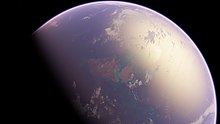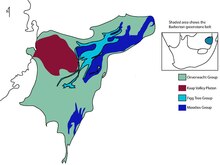| Paleoarchean | |||||||||||
|---|---|---|---|---|---|---|---|---|---|---|---|
| 3600 – 3200 Ma Pha. Proterozoic Archean Had. | |||||||||||
 The Vaalbara continent, a continent dating from 2.7 to 3.6 billion years ago The Vaalbara continent, a continent dating from 2.7 to 3.6 billion years ago | |||||||||||
| Chronology | |||||||||||
| |||||||||||
| Proposed redefinition(s) | 4031–3490 Ma Gradstein et al., 2012 | ||||||||||
| Proposed subdivisions | Acastan Period, 4031–3810 Ma Gradstein et al., 2012 | ||||||||||
| Etymology | |||||||||||
| Name formality | Formal | ||||||||||
| Alternate spelling(s) | Palaeoarchaean | ||||||||||
| Synonym(s) | Early Archean | ||||||||||
| Usage information | |||||||||||
| Celestial body | Earth | ||||||||||
| Regional usage | Global (ICS) | ||||||||||
| Time scale(s) used | ICS Time Scale | ||||||||||
| Definition | |||||||||||
| Chronological unit | Era | ||||||||||
| Stratigraphic unit | Erathem | ||||||||||
| Time span formality | Formal | ||||||||||
| Lower boundary definition | Defined Chronometrically | ||||||||||
| Lower GSSA ratified | 1991 | ||||||||||
| Upper boundary definition | Defined Chronometrically | ||||||||||
| Upper GSSA ratified | 1991 | ||||||||||
The Paleoarchean (/ˌpeɪlioʊ.ɑːrˈkiːən, ˌpæl-/ PAY-lee-oh-ar-KEE-ən, PAL-), also spelled Palaeoarchaean (formerly known as the early Archean), is a geologic era within the Archean Eon. The name derives from Greek "Palaios" ancient. It spans the period of time 3,600 to 3,200 million years ago. The era is defined chronometrically and is not referenced to a specific level of a rock section on Earth. The earliest confirmed evidence of life comes from this era, and Vaalbara, one of Earth's earliest supercontinents, may have formed during this era.
Early life

The geological record from the Paleoarchean era is very limited. Due to deformation and metamorphism, most rocks from the Paleoarchean era cannot provide any useful information. There are only two locations in the world containing rock formations that are intact enough to preserve evidence of early life: the Kaapvaal Craton in Southern Africa and the Pilbara Craton in Western Australia.
The Dresser Formation is located in the Pilbara Craton, and contains sedimentary rock from the Paleoarchean Era. It is estimated to be 3.48 billion years old. The Dresser Formation includes a great variety of structures caused by ancient life including stromatolites and MISS once formed by microbial mats. Such microbial mats belong to the oldest ascertained life form and may include fossilized bacteria. The Strelley Pool Chert, also located in the Pilbara Craton, contains stromatolites that may have been created by bacteria 3.4 billion years ago. However, it is possible that these stromatolies are abiogenic and were actually formed through evaporitic precipitation then deposited on the sea floor.
The Barberton Greenstone Belt, located in the Kaapvaal Craton, also contains evidence of life. It was created around 3.26 Ga when a large asteroid, about 37 to 58 kilometres (23–36 mi) wide, collided with the Earth. The Buck Reef chert and the Josefsdal chert, two rock formations in the Barberton Greenstone Belt, both contain microbial mats with fossilized bacteria from the Paleoarchean era. The Kromberg Formation, near the top of the Onverwacht Group which itself is a part of the Barberton Greenstone Belt, dates back to approximately 3.416–3.334 Ga and contains evidence of microbial life reproducing via multiple fission and binary fission.
Continental development


Similarities between the Barberton Greenstone Belt in the Kaapvaal Craton and the eastern part of the Pilbara Craton indicate that the two formations were once joined as part of the supercontinent Vaalbara, one of Earth's earliest supercontinents. Both cratons formed at the beginning of the Paleoarchean era. While some paleomagnetic data suggests that they were connected during the Paleoarchean era, it is possible that Vaalbara did not form until the Mesoarchean or Neoarchean eras.
It is also unclear whether there was any exposed land during the Paleoarchean era. Although several Paleoarchean formations such as the Dresser Formation, the Josefsdal Chert, and the Mendon Formation show some evidence of being above the surface, over 90 percent of Archean continental crust has been destroyed, making the existence of exposed land practically impossible to confirm or deny. It is likely that during the Paleoarchean era, there was a large amount of continental crust, but it was still underwater and would not emerge until later in the Archean era. Hotspot islands may have been the only exposed land at the time.
Due to a much hotter mantle and an elevated oceanic geothermal gradient compared to the present day, plate tectonics in its modern form did not exist during the Paleoarchean. Instead, a model of "flake tectonics" has been proposed for this era of geologic time. According to this model, instead of normal subduction of oceanic plates, extensively silicified upper oceanic crust delaminated from lower oceanic crust and was deposited in a manner similar to ophiolites from the later Proterozoic and Phanerozoic eons.
Meteoric impact
Researchers from Harvard, Stanford, and ETH Zürich reckon that the S2 meteorite impact that occurred in this era was from 50 to 200 times the size of the meteorite impact that largely caused the Cretaceous–Paleogene extinction event. It occurred approximately 3.26 billion years ago. The impact immediately redistributed iron(II) (Fe) from the lower oceanic chemocline through tsunamis that probably continued for days. In the next years and decades, several things occurred. Dust from the bolide containing phosporous and iron fell on land and into the sea. Weathering and erosion brought new material ("fallback") into the sea, including new crystallite (also called grains) pseudomorphs. The heat generated through the collision continuously boiled the upper layers of water, which concentrated the Fe, organic carbon, and various nutrients. Over thousands of years, these processes created iron(III) hydroxide (Fe(OH)
3) in both sea and sediment that would benefit iron-favoring bacteria and archaea. This meant that these Paleoarchean life forms would have recovered rapidly.
References
- Caredona, Tanai (6 March 2018). "Early Archean origin of heterodimeric Photosystem I". Heliyon. 4 (3): e00548. Bibcode:2018Heliy...400548C. doi:10.1016/j.heliyon.2018.e00548. PMC 5857716. PMID 29560463. Retrieved 25 February 2021.
- ^ Lepot, Kevin (2020). "Signatures of early microbial life from the Archean (4 to 2.5 Ga) eon". Earth-Science Reviews. 209: 103296. Bibcode:2020ESRv..20903296L. doi:10.1016/j.earscirev.2020.103296. hdl:20.500.12210/62415. ISSN 0012-8252. S2CID 225413847.
- ^ Bradley, Kyle; Weiss, Benjamin P.; Buick, Roger (2015). "Records of geomagnetism, climate, and tectonics across a Paleoarchean erosion surface". Earth and Planetary Science Letters. 419: 1–13. Bibcode:2015E&PSL.419....1B. doi:10.1016/j.epsl.2015.03.008. ISSN 0012-821X.
- ^ Homann, Martin (2019). "Earliest life on Earth: Evidence from the Barberton Greenstone Belt, South Africa" (PDF). Earth-Science Reviews. 196: 102888. Bibcode:2019ESRv..19602888H. doi:10.1016/j.earscirev.2019.102888. ISSN 0012-8252. S2CID 198424907.
- van Kranendonk, Martin J. (2007). "Chapter 7.2 A review of the evidence for putative Paleoarchean life in the Pilbara craton, Western Australia". In van Kranendonk, Martin J.; Smithies, R. Hugh; Bennett, Vickie C. (eds.). Developments in Precambrian Geology. Earth's Oldest Rocks. Vol. 15. Elsevier. pp. 855–877. doi:10.1016/s0166-2635(07)15072-6. ISBN 9780444528100. Retrieved 2021-11-26.
- "Scientists reconstruct ancient impact that dwarfs dinosaur-extinction blast" (Press release). American Geophysical Union. 9 April 2014.
- Kaźmierczak, Józef; Kremer, Barbara (1 September 2019). "Pattern of cell division in ~3.4 Ga-old microbes from South Africa". Precambrian Research. 331: 1–9. Bibcode:2019PreR..33105357K. doi:10.1016/j.precamres.2019.105357. S2CID 189977450. Retrieved 17 December 2022.
- van Kranendonk, Martin J.; Smithies, R. Hugh; Griffin, William L.; Huston, David L.; Hickman, Arthur H.; Champion, David C.; Anhaeusser, Carl R.; Pirajno, Franco (2015). "Making it thick: a volcanic plateau origin of Palaeoarchean continental lithosphere of the Pilbara and Kaapvaal cratons". Geological Society, London, Special Publications. 389 (1): 83–111. Bibcode:2015GSLSP.389...83V. doi:10.1144/SP389.12. ISSN 0305-8719. S2CID 130084679.
- Korenaga, Jun (2021). "Was there land on the early Earth?". Life. 11 (11): 1142. Bibcode:2021Life...11.1142K. doi:10.3390/life11111142. PMC 8623345. PMID 34833018.
- Grosch, Eugene G.; Viola, Giulio; Ndlela, Sibusisiwe (15 August 2020). "Geological record of Paleoarchean oceanic flake tectonics preserved in the c. 3.3 Ga Kromberg volcanic type-section, Barberton greenstone belt, South Africa". Precambrian Research. 346: 105815. Bibcode:2020PreR..34605815G. doi:10.1016/j.precamres.2020.105815. S2CID 225451582. Retrieved 17 December 2022.
- Harvard University (2024-10-23). "3 Billion Years Ago, a Meteorite the Size of Four Mount Everests Struck Earth – Changing Life Forever". SciTechDaily. Retrieved 2024-10-24.
- Drabon, Nadja; et al. (2024-10-21). "Effect of a giant meteorite impact on Paleoarchean surface environments and life". Proceedings of the National Academy of Sciences. 121 (44). Proceedings of the National Academy of Sciences. doi:10.1073/pnas.2408721121. ISSN 0027-8424.
External links
| Archean Eon | |
|---|---|